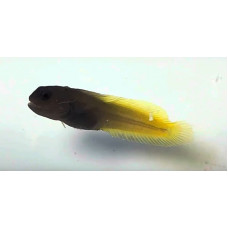Latin name
Ecsenius bicolor
Other name
Bicolor blenny
Identification
Flame tail blennies have an elongated body with a cylindrical shape.
Features of fish fins
Dorsal spines (total): 11 - 12; Dorsal soft rays (total): 15 - 18; Anal spines: 2; Anal soft rays: 17 - 21.
Fish colouring
It comes in three colours: one is black on the front and yellow on the back (bicolour phase), the others are black on the back with a broad white stripe on the sides and a dark belly with or without a yellow tail.
Distribution
Widespread in the Indo-Pacific: from the Maldives to the Phoenix Islands, north to the Ryukyu Islands, south to the southern Great Barrier Reef; throughout Micronesia.
Habitat
Marine tropical species associated with reefs. Depth from 1 to 25 metres.
Size
The flame tail blenny grows to 11 centimetres in length.
Behavior
Flame tail blennies are found solitary in clear lagoons and on nearshore reefs with mixed corals and algae-covered rocks.
Food and feeding habits
Their diet consists of algae and detritus obtained by scraping the hard rocky substrate. They also feed on coral polyps, which are an important part of their diet.
Reproduction
Egg-laying. Eggs are ground laying and adhesive. They adhere to the substrate with a fibrous adhesive pad or support. Larvae are planktonic and often inhabit shallow coastal waters.
Fishing
This species is commercially important in fisheries.
Relationship with a person
Harmless. This species is often sold in aquaria.
| Classification | |
| Phylum | Chordata |
| Class | Actinopterygii |
| Squad | Blenniiformes |
| Family | Blenniidae |
| Genus | Ecsenius |
| Species | E. bicolor |
| Features | |
| Conservation status | Least Concern |
| Habitat | Pelagic |
| Life span, years | No information |
| Maximum body weight, kg | No information |
| Maximum length, cm | 11 |
| Sailing speed, m/s | No information |
| Threat to people | Not edible |
| Way of eating | Planktonophage |
Flame tail blenny
Tags: flame tail blenny



